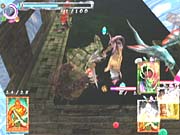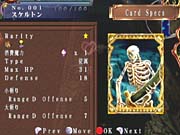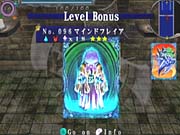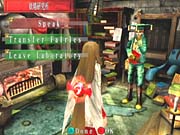Lost Kingdoms Updated Preview
From Software and Activision are bringing their action-packed RPG to the Nintendo GameCube.
Last month, we took a first look at Lost Kingdoms, From Software and Activision's upcoming action RPG for the GameCube. As Princess Katia, you are challenged to save your realm from the dark fog that is enveloping the good people, armed only with the magical abilities of your deck of cards. Being able to bring forth magic from these cards is a special talent in Katia's world, although the rarity of a female wielder of this ability is made clear in the game's early running.
Players may be misled to believe that Lost Kingdoms is a collectible card game, similar to Pokémon, Magic the Gathering, or Digimon, when in actuality, the cards are simply a colorful visual representation of various powers and attacks that become available to the game's protagonist as the game progresses. Four of Katia's cards are drawn at the start of every battle, displayed onscreen in a position relative to the GameCube's four face buttons. Pressing the corresponding button will activate the selected card, which, once depleted, is replaced by the next card in the deck, as displayed in the lower left-hand corner.

What Lost Kingdoms does borrow from traditional card-battling games are the collection and deck-building aspects. As you venture from stage to stage, you will open chests and be rewarded with new, versatile, and more powerful cards with which you can construct a 30-card deck. This deck is your sole source for offensive and defensive capabilities during encounters with the creatures of Katia's world, so packing a mix of different abilities can be as effective as specializing in a favorite tactic.
There are three different types of creature cards to choose from when constructing decks. They include weapon attacks, summonings, and transformations. Weapon attacks, like those found in the lizardman cards, let you quickly bring forth a specter of a monster, which strikes out in the chosen direction. Among the first cards you receive, an avian creature will act as a strike, swooping forth in a straight line from high above, capable of damaging any enemies in direct line of sight. The aforementioned lizardman cards are more akin to melee attacks, since their brief sword swing has a close range but packs a more powerful punch. Weapon cards are usually good for a couple of attacks, with portions of the card onscreen being burnt away to show how much of the card's charge is left. A fully exhausted card disappears from the deck, returning only at the end of a stage.
Summoning cards bring forth a previously defeated creature to fight on your side. In this way, distractions can be tossed onto the battlefield, and some of them are quite powerful and are legitimate threats on their own. The giant "fly-trap plant" monster is an example of an early summon that swipes at opposing enemies in all directions with its vine tentacles. Skeletons and pigmen can also serve useful in the early going when called forth to fight alongside you.
Completing Katia's collection are the transformation cards, which are generally the most powerful cards in your arsenal. These cards transform Katia into the summoned creature, allowing her to deliver a single powerful strike or spell. These cards are one-shot only but are generally powerful enough to dispose of creatures outright.

An alternate method of using these cards exists, and this involves trapping an enemy creature and transforming it into a card you can use. While at any time you can choose to ditch a card, you can instead choose to toss a card at an injured enemy to replace an attack, in hopes of striking the final blow. If this direct card attack succeeds, the enemy is transformed into a card, which can then be added to your decks.
Magical energies are required to power these cards, and this energy is accumulated throughout Katia's travels in the form of mana crystals, which come in both pink and blue shades. These crystals also come in varying sizes, according to how much energy they impart. Damaging or destroying hostile creatures will release a number of these crystals, which Katia must race to snatch up before they wink away. Destructible environments that catch the brunt of a spell or creature's attack may also release crystals-- oftentimes, this is how you can reach secret areas or treasure chests.
Proper deck construction takes into account a number of factors, including element types, the prediction of what sorts of enemies will be encountered, and which cards will need to be saved as reserves if your initial stockpile becomes exhausted. Minor nuisances such as skeletons and lizardmen can be dealt with easily by a weak summoned creature, while you'll have to pull out all the stops to take down challenging boss enemies.
Facing random encounters and boss challenges isn't merely a matter of survival. Each battle is ranked in terms of life lost, experience gained, and cards used. The best possible scores will be earned when totally evading injury and when a minimum of cards are used up. Good performances will earn you a five-star ranking at the stage's end and give you a chance to choose three cards out of the six presented, one of which is a high-rarity card representing the boss creature, which is difficult to earn otherwise.

Unlike many of today's traditional RPGs, Lost Kingdoms plays much like an action game, laid out in stages with predefined objectives and completion requirements. Areas and portions of the world can't be revisited; instead, newly unlocked stages must be progressed through in nearly linear fashion. Occasionally your path will provide for options, but generally you'll need to stick to a predetermined path throughout the game.
Katia will find a variety of characters on her journey, two of which provide recurring assistance during her adventures as a break from the nonstop battling. The old woman whom Katia meets during her training session is named Gund, and she runs the card shop, which you will be visiting frequently between stages. At the shop, you overhear rumors and gossip, which occasionally unlocks new areas to explore and provides information concerning events that transpire elsewhere in the world. The card shop provides an abundance of services, not the least of which is the buying and selling of cards. Gold is earned in Katia's adventure in a variety of ways, but it will be accumulated mostly through the sale of excess cards in her stockpile. As cards gain experience, they gain potential options, including the ability to transmute into potentially more powerful cards or to self-duplicate. Duplicate copies of cards pool their experience together, but the benefits of experience usage apply only to a single card--that is, a single card is transmuted or duplicated. However, using multiple copies of a single card in a deck is a sure way to get to the desired transmuted form as quickly as possible.

The second character who provides lasting assistance is an aristocratic, learned fellow who offers Katia new, valuable cards in exchange for the recovery of a certain intelligent creature he is researching--red fairies. Blue fairies are silent and skittish, and they often need to be chased when encountered in the wilds. However, they provide minute health or energy bonuses when caught. Red fairies, on the other hand, provide useful information and will tag along with you when found. You can then leave them in the protection of the fairy hut owner, who will compensate you accordingly.
Those players familiar with modern RPGs will be immediately familiar with many of the basics of Lost Kingdoms. There were easily accomplishable puzzle elements, involving the activation of switches, as well as an abundance of examinable items and NPCs who relay much of the storyline, as opposed to scripted cinematic sequences. To its credit, nearly all of Lost Kingdoms takes place with you in control, and the game never takes the characters and world out of real time. The version of Lost Kingdoms we played wasn't fully localized, but what we were able to glean of the plot showed us that the game's developers weren't straying far from what we've seen in other RPGs in the past. We'll have more on Lost Kingdoms as it approaches its stateside release later this month.
Got a news tip or want to contact us directly? Email news@gamespot.com
Join the conversation